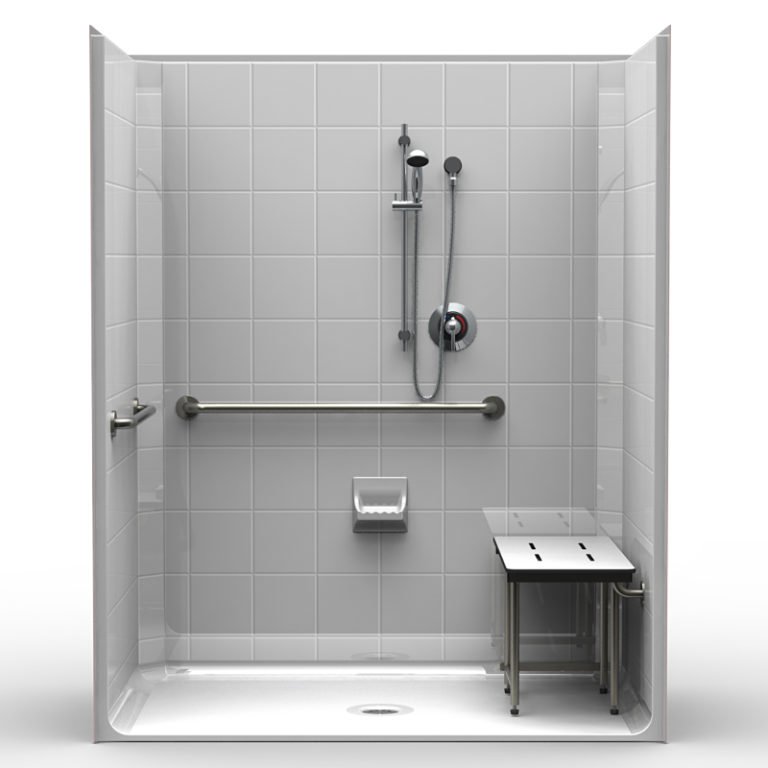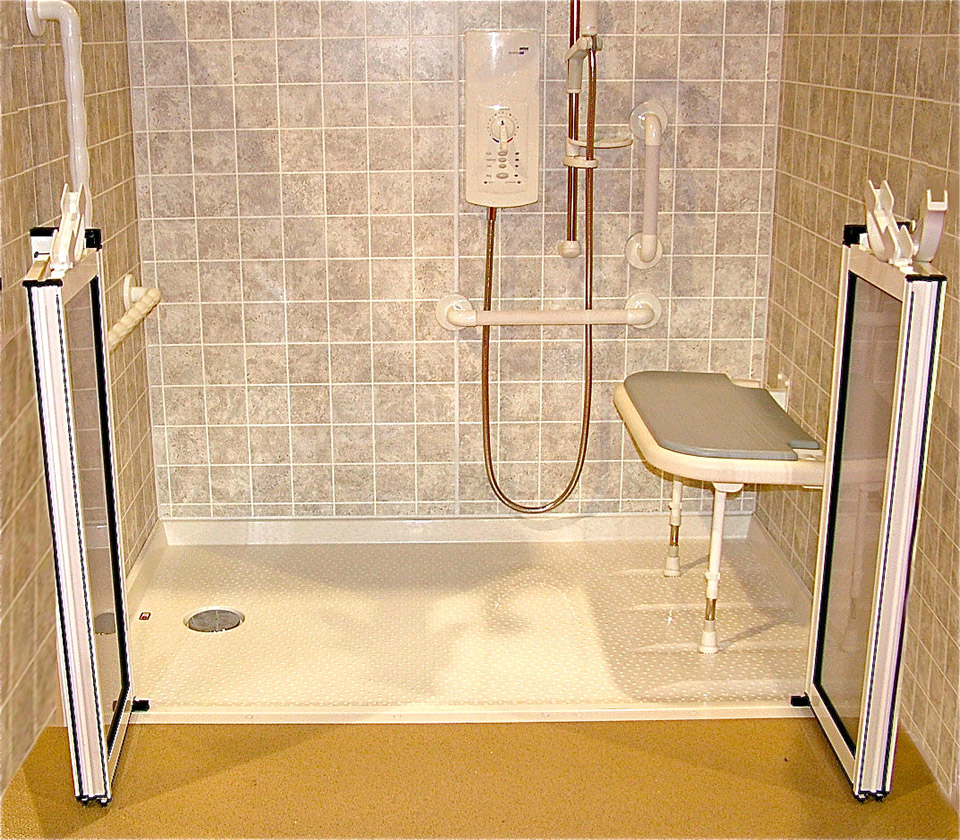Types of Handicap Bathroom Shower Pans

Handicap bathroom shower pans are essential for creating accessible and safe bathing spaces for individuals with disabilities. These specialized pans come in various materials and designs, each offering unique benefits and considerations.
Materials Used in Handicap Bathroom Shower Pans
The material of a handicap bathroom shower pan significantly impacts its durability, maintenance requirements, and aesthetic appeal.
- Acrylic: Acrylic shower pans are known for their smooth, non-porous surface, making them easy to clean and resistant to mold and mildew growth. They are also relatively lightweight, making installation easier. However, acrylic can be prone to scratches and may not be as durable as other materials.
- Fiberglass: Fiberglass shower pans offer good durability and resistance to impact, making them a popular choice for high-traffic areas. They are also relatively affordable. However, fiberglass can be more difficult to clean than acrylic and may not be as aesthetically pleasing.
- Tile: Tile shower pans offer a wide range of design options and can be customized to match any bathroom decor. Tile is also very durable and resistant to scratches and stains. However, tile installation can be more complex and time-consuming, and grout lines require regular cleaning to prevent mold and mildew growth.
Accessibility Features of Handicap Shower Pans
Handicap bathroom shower pans are designed with specific features to ensure accessibility and safety for individuals with disabilities.
- Curbless Entry: Curbless entry showers eliminate the barrier of a traditional shower threshold, allowing easy access for wheelchair users and individuals with mobility impairments.
- Slip-Resistant Surfaces: The shower pan’s surface should have a slip-resistant texture to prevent falls, especially for individuals with limited balance.
- Grab Bars: Strategically placed grab bars provide support and stability for individuals who need assistance getting in and out of the shower.
Designs of Handicap Shower Pans
Handicap bathroom shower pans are available in various designs to accommodate different needs and preferences.
- Walk-in Showers: Walk-in showers have a low entry threshold, allowing easy access for individuals who may have difficulty stepping over a traditional shower curb.
- Roll-in Showers: Roll-in showers are designed specifically for wheelchair users, with a wide entryway that allows a wheelchair to roll directly into the shower area.
- Shower Stalls with Benches: Shower stalls with benches provide a place to sit while showering, offering support and reducing fatigue for individuals who have difficulty standing for extended periods.
Installation and Maintenance of Handicap Shower Pans

Installing and maintaining a handicap shower pan is crucial for ensuring accessibility, safety, and longevity. Proper installation ensures the pan functions correctly and meets accessibility standards, while regular maintenance prevents issues and extends its lifespan.
Installation of Handicap Shower Pans, Handicap bathroom shower pans
Installing a handicap shower pan requires careful planning and execution to ensure proper functionality and accessibility. It involves several steps, including preparing the subfloor, setting the pan, and waterproofing.
- Preparing the Subfloor: A level and solid subfloor is essential for a stable and properly functioning shower pan. The subfloor should be inspected for any unevenness or rot. Any damage should be repaired before proceeding.
- Setting the Pan: The shower pan should be carefully set on the prepared subfloor, ensuring it is level and plumb. The pan should be secured to the subfloor using appropriate fasteners.
- Waterproofing: Waterproofing is crucial to prevent water damage and leaks. A waterproof membrane should be applied around the perimeter of the pan and under the pan itself. This membrane should be properly sealed to prevent water from penetrating the subfloor.
Maintenance of Handicap Shower Pans
Regular maintenance is crucial for extending the lifespan of a handicap shower pan and preventing issues such as mold growth and leaks. This includes cleaning the pan, preventing mold growth, and repairing minor damage.
- Cleaning: The shower pan should be cleaned regularly to remove dirt, soap scum, and other debris. Mild cleaners and a soft brush can be used to avoid damaging the surface.
- Preventing Mold Growth: Mold can grow in damp environments, so it’s essential to keep the shower pan clean and dry. Proper ventilation is also crucial for preventing mold growth.
- Repairing Minor Damage: Minor damage, such as cracks or chips, should be repaired promptly to prevent further damage and leaks. A qualified contractor can repair minor damage using appropriate materials and techniques.
Hiring a Qualified Contractor
Hiring a qualified contractor for the installation of a handicap shower pan is crucial to ensure proper accessibility, safety, and functionality. A qualified contractor will have the experience and expertise to install the pan correctly and meet accessibility standards.
Common Problems and Troubleshooting
Common problems with handicap shower pans include leaks, cracks, and drainage issues. These problems can be caused by improper installation, wear and tear, or poor maintenance.
- Leaks: Leaks can occur due to cracks in the pan, faulty waterproofing, or loose connections. To troubleshoot leaks, check the pan for cracks and inspect the waterproofing membrane for damage. If the leak is due to a loose connection, tighten the connection or replace the faulty part.
- Cracks: Cracks in the pan can be caused by stress, impact, or improper installation. To repair cracks, use a suitable sealant or epoxy.
- Drainage Issues: Drainage issues can be caused by clogs in the drain or a faulty drain trap. To troubleshoot drainage issues, check the drain for clogs and clean it if necessary. If the drain trap is faulty, it should be replaced.
Choosing the Right Handicap Bathroom Shower Pan: Handicap Bathroom Shower Pans

Choosing the right handicap bathroom shower pan is crucial for ensuring safety, accessibility, and comfort. This decision involves considering various factors, such as the space available, personal preferences, and budget.
Factors to Consider When Choosing a Handicap Bathroom Shower Pan
Choosing the right handicap shower pan involves considering several key factors, ensuring a safe, accessible, and comfortable showering experience.
- Size: The shower pan size should accommodate the user’s mobility needs, providing ample space for movement and turning. A standard size for a handicap shower pan is 36 inches by 36 inches, but larger sizes may be necessary for wheelchair users or individuals with limited mobility.
- Shape: Shower pans come in various shapes, including square, rectangular, and curved. Consider the available space and the user’s needs when selecting a shape. A curved shower pan can provide more space for turning, while a rectangular pan might be more suitable for a smaller bathroom.
- Budget: Handicap shower pans are available in a wide range of prices, depending on the materials, features, and brand. Set a realistic budget and explore options within that range. Consider the long-term value of a durable and high-quality shower pan.
- Personal Preferences: Consider the user’s preferences for materials, colors, and design. A shower pan that complements the bathroom’s aesthetic and meets the user’s needs will enhance the overall experience.
Checklist of Features to Look for in a Handicap Shower Pan
Ensure the chosen shower pan incorporates essential features for safety, accessibility, and comfort.
- ADA Compliance: The shower pan should meet the Americans with Disabilities Act (ADA) standards for accessibility. This includes having a minimum width of 36 inches, a grab bar height of 33 to 36 inches, and a seat height of 17 to 19 inches.
- Slip Resistance: A slip-resistant surface is crucial for preventing accidents. Look for a shower pan with a textured surface or a non-slip coating. This feature is particularly important for individuals with limited mobility or balance issues.
- Water Drainage: An efficient drainage system is essential for preventing water buildup and potential safety hazards. Ensure the shower pan has a drain with a large enough opening to accommodate the water flow and prevent clogging.
- Material: Handicap shower pans are typically made from materials like fiberglass, acrylic, or tile. Consider the durability, ease of cleaning, and aesthetics of each material when making a decision. Fiberglass is known for its durability and affordability, while acrylic is more aesthetically pleasing but may be less durable.
Measuring the Space for a Handicap Shower Pan
Accurately measuring the available space is essential for choosing the right size shower pan and ensuring proper installation.
- Measure the Width and Length: Use a tape measure to determine the width and length of the area where the shower pan will be installed. Ensure you account for any obstructions, such as walls, doors, or fixtures.
- Measure the Height: Measure the height from the floor to the desired shower pan height. Consider the user’s height and mobility needs when determining the appropriate height.
- Determine the Slope: Ensure the shower floor has a slight slope towards the drain to allow for proper water drainage. A slope of 1/4 inch per foot is recommended for handicap showers.
Comparison of Different Brands and Models of Handicap Shower Pans
The following table provides a comparison of different brands and models of handicap shower pans, highlighting their key features and pricing:
| Brand | Model | Size | Material | Features | Price (USD) |
|---|---|---|---|---|---|
| Moen | Shower Base | 36″ x 36″ | Fiberglass | ADA compliant, slip-resistant surface, integrated drain | $500 – $800 |
| Kohler | Walk-In Shower Base | 36″ x 36″ | Acrylic | ADA compliant, slip-resistant surface, adjustable height | $600 – $1000 |
| American Standard | Shower Pan | 36″ x 36″ | Tile-ready | ADA compliant, slip-resistant surface, multiple drain options | $400 – $700 |
| Delta | Shower Base | 36″ x 36″ | Fiberglass | ADA compliant, slip-resistant surface, integrated drain, multiple color options | $550 – $900 |
Handicap bathroom shower pans are designed with accessibility in mind, often featuring low thresholds and non-slip surfaces. While these pans prioritize safety and ease of use, the overall bathroom experience can be enhanced with thoughtful design elements, such as best bathroom towel hooks.
These hooks, strategically placed within reach, provide a convenient way to hang towels and robes, further contributing to a comfortable and functional bathroom space for all users.
Handicap bathroom shower pans are designed for accessibility, often featuring low thresholds and wider spaces. While these features are crucial for safety and ease of use, they can also create unique challenges in terms of odor control. To combat lingering smells, consider utilizing a best odor eliminator spray for bathroom that effectively neutralizes and eliminates odors.
This will help maintain a fresh and pleasant environment in your handicap bathroom, contributing to a positive user experience.